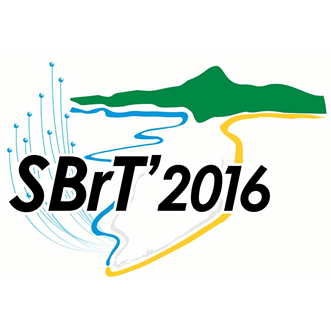
XXXIV Simpósio Brasileiro de Telecomunicações
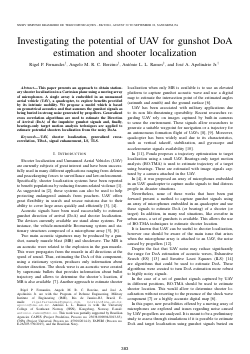
Investigating the potential of UAV for gunshot DoA estimation and shooter localization
Rigel P. Fernandes, Angelo M. R. C. Borzino, António L. L. Ramos, José A. Apolinário Jr.
DOI: 10.14209/sbrt.2016.52
Keywords: UAV shooter localization generalized crosscorrelation TDoA signal enhancement LS TLS
Abstract
This paper presents an approach to obtain stationary shooter localization in a Cartesian plane using a moving array of microphones. A single array is embedded in an unmanned aerial vehicle (UAV), a quadcopter, to explore benefits provided by its intrinsic mobility. We propose a model which is based on geometrical acoustics and that assumes the gunshot signals as being buried in strong noise generated by propellers. Generalized cross correlation algorithms are used to estimate the Direction of Arrival (DoA) of the impulsive gunshot signals and, finally, bearings-only target motion analysis techniques are applied to estimate potential shooters localization from the noisy DoAs.Download
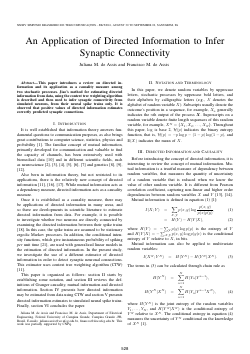
An Application of Directed Information to Infer Synaptic Connectivity
Juliana M. de Assis, Francisco M. de Assis
DOI: 10.14209/sbrt.2016.53
Keywords:
Abstract
This paper introduces a review on directed in-formation and its application as a causality measure among two stochastic processes. Jiao’s method for estimating directed information from data, using the context tree weighting algorithm is described and then used to infer synaptic connectivity from simulated neurons, from their neural spike trains only. It is observed that positive values of directed information estimates correctly predicted synaptic connections.Download
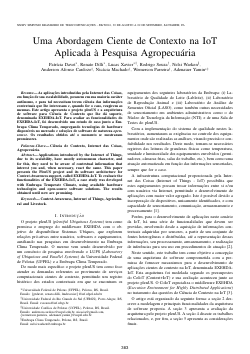
Uma Abordagem Ciente de Contexto na IoT Aplicada à Pesquisa Agropecuária
Patrícia Davet, Renato Dilli, Lucas Xavier, Rodrigo Souza†, Nelsi Warken§, Anderson Afonso Cardozo, Nicácia Machado, Wemerson Parreira, Adenauer Yamin
DOI: 10.14209/sbrt.2016.54
Keywords: Ciência de Contexto Internet das Coisas Agropecuária
Abstract
As aplicações introduzidas pela Internet das Coisas, em função de sua escalabilidade, possuem em sua maioria caráter autônomo, e para tal necessitam terem ciência das informaç˜oes contextuais que lhe interessam e, quando for o caso, reagirem as mesmas. Este artigo apresenta o projeto plenUS e a arquitetura de software para Ciência de Contexto que lhe dásuporte, denominada EXEHDA-IoT. Para avaliar as funcionalidades do EXEHDA-IoT, foi desenvolvido um estudo de caso junto a Em-brapa Clima Temperado, empregando tecnologias de hardware disponíveis no mercado e soluções de software de natureza open-source. Os resultados obtidos atéo momento se mostraram promissores.Download
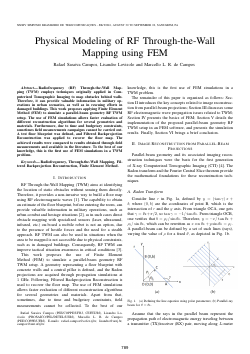
Physical Modeling of RF Through-the-Wall Mapping using FEM
Rafael Saraiva Campos, Lisandro Lovisolo, Marcello L. R. de Campos
DOI: 10.14209/sbrt.2016.58
Keywords: Radiofrequency Through-the-Wall Mapping Filtered Backprojection Reconstruction Finite Element Method.
Abstract
Radiofrequency (RF) Through-the-Wall Mapping (TWM) employs techniques originally applied in Computerized Tomographic Imaging to map obstacles behind walls. Therefore, it can provide valuable information in military operations in urban scenarios, as well as in rescuing efforts in damaged buildings. This work proposes applying Finite Element Method (FEM) to simulate a parallel-beam geometry RF TWM setup. The use of FEM simulations allows faster evaluation of different reconstruction algorithms for several geometries and materials. Furthermore, due to time and budgetary constraints, sometimes field measurements campaigns cannot be carried out. A test floor blueprint was defined, and Filtered Backprojection Reconstruction was applied to recover the floor map. The achieved results were compared to results obtained through field measurements and available in the literature. To the best of our knowledge, this is the first use of FEM simulations in a TWM problem.Download
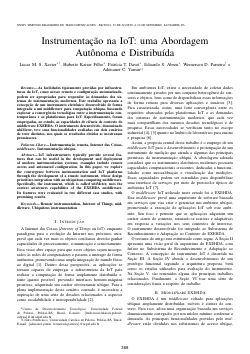
Instrumentação na IoT: uma Abordagem Autônoma e Distribuída
Lucas M. S. Xavier, Huberto Kaiser Filho, Patrícia T. Davet, Eduardo S. Abreu, Wemerson D. Parreirat, Adenauer C. Yamin
DOI: 10.14209/sbrt.2016.55
Keywords: Instrumentação remota Internet das Coisas middleware Instrumentação ubíqua
Abstract
As facilidades tipicamente providas por infraestru-turas da IoT, como acesso remoto e configuração automatizada, podem ser apropriadas para responder às demandas dos sis-temas de instrumentação modernos. Este trabalho apresenta a concepção de um instrumento eletrônico desenvolvido de forma integrada a um middleware para computação ubíqua, buscando explorar a convergência tecnológica entre a instrumentação con-temporânea e as plataformas para IoT. Especificamente, foram empregadas, no estudo, as capacidades de ciência de contexto do middleware EXEHDA. O instrumento desenvolvido, denominado ubiMeter, teve suas funcionalidades avaliadas em dois cenários de teste distintos, nos quais os resultados obtidos se mostraram promissores.Download
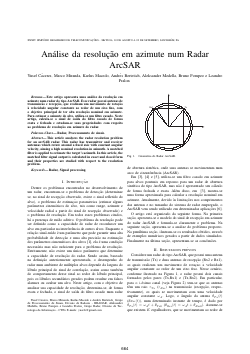
Análise da resolução em azimute num Radar ArcSAR
Yusef Cáceres, Marco Miranda, Karlus Macedo, Andrés Bertetich, Aleksander Medella, Bruno Pompeo, Leandro Pralon
DOI: 10.14209/sbrt.2016.56
Keywords: Radar Processamento de sinais.
Abstract
Este artigo apresenta uma análise da resolução em azimute num radar do tipo ArcSAR. Esse radar possui antenas de transmissão e recepção, que realizam um movimento de rotação à velocidade angular constante ao redor de um eixo fixo, com o objetivo principal de ter alta resolução nominal em azimute. Para estimar o azimute do alvo, utiliza-se um filtro casado. Neste artigo, calcula-se o sinal de saída do filtro casado de forma exata e fechada e estudam-se suas propriedades com respeito ao problema de resolução em azimute do radar.Download
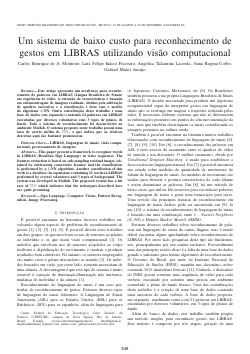
Um sistema de baixo custo para reconhecimento de gestos em LIBRAS utilizando visão computacional
Carlos Henrique de A. Monteiro, Luiz Felipe Inácio Pecoraro, Angélica Takamine Lacerda, Anna Regina Corbo, Gabriel Matos Araujo
DOI: 10.14209/sbrt.2016.57
Keywords: LIBRAS linguagem de sinais visão compu-tacional processamento de imagens
Abstract
Este artigo apresenta um arcabouço para reconhe-cimento de palavras em LIBRAS (Língua Brasileira de Sinais) em sequências de vídeo. A extração de características é baseada em subamostragem de imagens residuais, obtidas pela subtração de quadros sucessivos e a classificação é feita com o auxílio do algoritmo k-NN. Outra contribuição deste trabalho é uma base de dados (em expansão) contendo 24 palavras em LIBRAS executadas por diversos voluntários com 3 tipos de planos de fundo. Todo o sistema de reconhecimento foi desenvolvido no ambiente Matlab. O sistema proposto neste trabalho possui uma taxa de acerto média de 75%, o que indica que as técnicas descritas aqui são bastante promissoras.Download
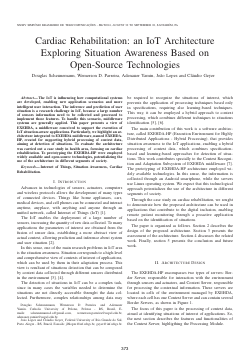
Cardiac Rehabilitation: an IoT Architecture Exploring Situation Awareness Based on Open-Source Technologies
Douglas Scheunemann, Wemerson D. Parreira, Adenauer Yamin, João Lopes, Cláudio Geyer
DOI: 10.14209/sbrt.2016.59
Keywords: Internet of Things Situation Awareness Cardiac Rehabilitation
Abstract
The IoT is influencing how computational systems are developed, enabling new application scenarios and more intelligent user interaction. The inference and prediction of user situation is a research challenge in IoT, because a large number of sensors information need to be collected and processed to implement those features. To handle this scenario, middleware systems are generally applied. This paper presents a view of EXEHDA, a middleware conceived to support the execution of IoT situation-aware applications. Particularly, we highlight an ar- chitecture integrated to EXEHDA middleware, named EXEHDA- HP, created for supporting hybrid processing of context data, aiming at detection of situations. To evaluate the architecture was carried out a case study in health area, focusing on cardiac rehabilitation. To prototyping the EXEHDA-HP were employed widely available and open-source technologies, potentializing the use of the architecture in different segments of society.Download
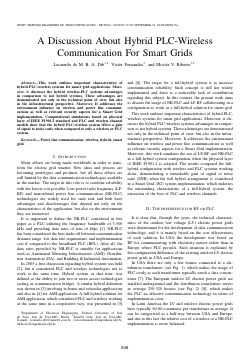
A Discussion About Hybrid PLC-Wireless Communication For Smart Grids
Leonardo de M. B. A. Dib, Victor Fernandes, Moisés V. Ribeiro
DOI: 10.14209/sbrt.2016.60
Keywords: Power line communication wireless hybrid smart grid.
Abstract
This work outlines important characteristics of hybrid PLC-wireless systems for smart grid applications. Moreover, it discusses the hybrid wireless-PLC systems advantages in comparison to not hybrid systems. These advantages are demonstrated not only in the technical point of view, but also in the infrastructural perspective. Moreover, It addresses the environment influence on wireless and power line communications as well as relevant security aspects for a Smart Grid implementation. Computational simulations based on physical layer of IEEE P1901.2 standard and PLC and wireless channel models show that the hybrid PLC-wireless system offers a gain of signal to noise ratio when compared to only a wireless or PLC system.Download
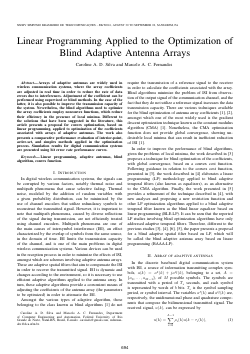
Linear Programming Applied to the Optimization of Blind Adaptive Antenna Arrays
Caroline A. D. Silva, Marcelo A. C. Fernandes
DOI: 10.14209/sbrt.2016.66
Keywords: Linear programming adaptive antennas blind algorithm convex function.
Abstract
Arrays of adaptive antennas are widely used in wireless communication systems, where the array coefficients are adjusted in real time in order to reduce the rate of data errors due to interferences. Adjustment of the coefficient can be performed using supervised or blind methods. In the case of the latter, it is also possible to improve the transmission capacity of the system. Nevertheless, the blind algorithms used to optimize the array coefficients employ nonconvex functions, which reduce their efficiency in the presence of local minima. Different to the solutions that have been suggested in the literature, this article presents a proposal for convex optimization, based on linear programming, applied to optimization of the coefficients associated with arrays of adaptive antennas. The work also presents a comparative performance evaluation of interior-point, active-set, and simplex methods applied in the optimization process. Simulation results for digital communication systems are presented using bit error rate performance curves.Download